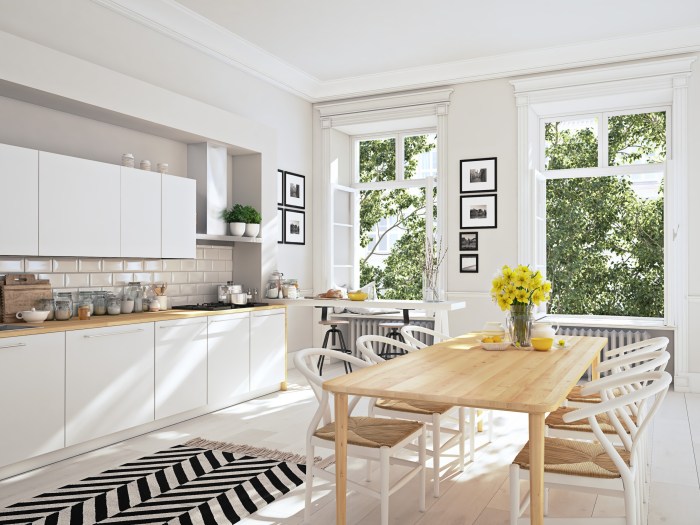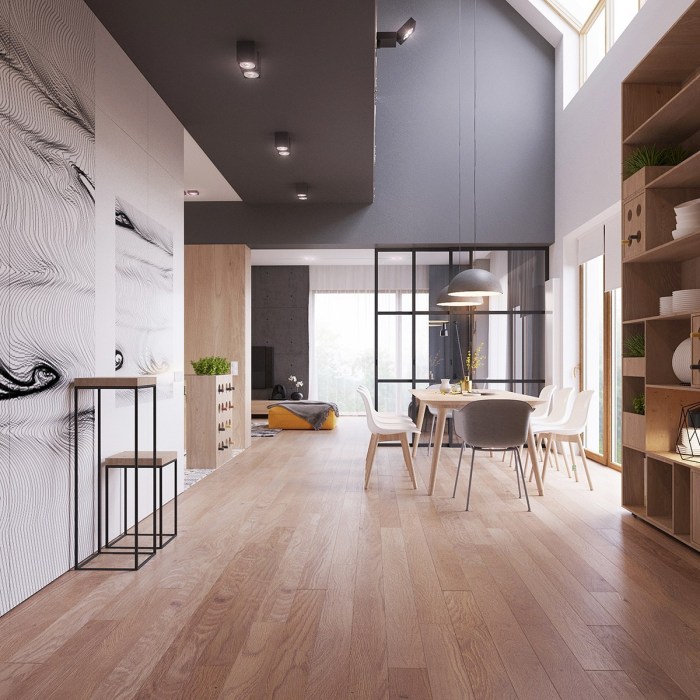Modern Scandinavian interior design sets the stage for this enthralling narrative, offering readers a glimpse into a story that is rich in detail and brimming with originality. From the key characteristics to the use of natural elements, this style encompasses a harmonious blend of simplicity and functionality that is sure to captivate all who venture into its realm.
As we delve deeper into the elements, materials, functionality, and layout of modern Scandinavian interiors, a world of clean lines, cozy textures, and practical design solutions unfolds before us, inviting us to explore the beauty and simplicity of this timeless aesthetic.
Elements of Modern Scandinavian Interior Design
Scandinavian interior design is known for its simplicity, functionality, and connection to nature. Let's explore the key elements that define modern Scandinavian interiors.
Natural Light in Scandinavian Design
One of the most important aspects of modern Scandinavian interior design is the emphasis on natural light. Large windows are common in Scandinavian homes to maximize the amount of daylight that enters the space. This helps create a bright and airy atmosphere, enhancing the overall aesthetic of the design.
Minimalist Furniture and Clean Lines
Another characteristic of modern Scandinavian interior design is the use of minimalist furniture and clean lines. Furniture pieces are often sleek, simple, and functional, with an emphasis on quality craftsmanship. This minimalist approach helps create a sense of calm and uncluttered space, allowing the focus to remain on the beauty of the design elements.
Color Palette in Scandinavian Interiors
The color palette commonly used in modern Scandinavian interiors is neutral and muted tones such as whites, grays, and light pastels. These soft colors help create a sense of tranquility and simplicity, while also allowing natural materials like wood and stone to stand out.
Accents of black or bold colors may be added for contrast and visual interest, but the overall look remains cohesive and harmonious.
Materials and Textures
In modern Scandinavian interior design, the use of specific materials and textures plays a crucial role in creating the desired aesthetic and ambiance.
Common Materials
- Wood: One of the most prevalent materials in Scandinavian design, wood adds warmth and natural elements to the space. Light wood tones like beech, pine, or birch are often used to enhance the light and airy feel of the interiors.
- Glass: Glass is frequently incorporated to allow natural light to flow through the space, creating a sense of openness and brightness.
- Metal: Metals like stainless steel, copper, or brass are used to add a touch of modernity and sophistication to the design.
Importance of Textures
Incorporating textures like cozy rugs, soft throws, and plush cushions is essential in modern Scandinavian interior design to create a sense of comfort and coziness. These textures not only add layers to the design but also invite people to relax and unwind in the space.
Natural Elements
- Plants: Bringing in plants and greenery is a key aspect of Scandinavian design, as it connects the interior space with nature. Plants not only add a pop of color but also improve air quality and create a sense of tranquility.
- Natural Fabrics: Using natural fabrics like linen, wool, and cotton further enhances the connection to nature and adds a tactile element to the design.
Functionality and Practicality

Functionality and practicality are key aspects of modern Scandinavian interior design, focusing on creating spaces that are not only visually appealing but also highly functional for everyday living. This design approach prioritizes simplicity, minimalism, and efficiency to ensure that each element serves a purpose while maintaining a clean and clutter-free aesthetic.
Multi-functional Furniture Pieces
In modern Scandinavian design, multi-functional furniture pieces are popular choices to maximize space and functionality. Examples include sofa beds that serve as seating during the day and transform into a bed for guests at night, extendable dining tables that adapt to different seating needs, and storage ottomans that provide extra seating while concealing clutter.
These versatile pieces help optimize small living spaces without compromising style or comfort.
The Concept of "Hygge"
One of the key principles of Scandinavian design is the concept of "hygge," which emphasizes creating cozy and inviting spaces that promote comfort and well-being. This concept is reflected in the use of soft textiles, warm lighting, natural materials, and a neutral color palette to evoke a sense of warmth and intimacy.
By incorporating elements of hygge into interior design, Scandinavian spaces feel welcoming and relaxing, encouraging moments of peace and contentment.
Layout and Spatial Planning
In modern Scandinavian interior design, the layout and spatial planning play a crucial role in creating a sense of harmony and functionality within a space.
Open Floor Plans
Open floor plans are a common feature in modern Scandinavian interiors as they promote a sense of flow and connectivity between different areas of the home. By eliminating unnecessary walls and barriers, open floor plans create a spacious and airy atmosphere that is characteristic of Scandinavian design.
Creating Space in Smaller Rooms
In smaller rooms, it is essential to maximize the sense of space and airiness to prevent them from feeling cramped. This can be achieved through the use of light colors, minimalistic furniture, and strategic placement of mirrors to reflect light and create the illusion of a larger space.
Optimizing Space
To optimize space in Scandinavian interiors, clever storage solutions and furniture placement are key. Consider incorporating multifunctional furniture pieces that serve dual purposes, such as a storage ottoman or a bed with built-in drawers. Additionally, utilizing vertical space through wall-mounted shelves and cabinets can help free up floor space and keep the room clutter-free.
Ending Remarks

In conclusion, modern Scandinavian interior design offers a unique blend of form and function, creating spaces that are both visually stunning and highly practical. By embracing the principles of simplicity, natural elements, and functionality, this design style paves the way for inviting and harmonious living spaces that exude a sense of tranquility and warmth.
Dive into the world of modern Scandinavian interior design and elevate your living space to new heights of style and comfort.
User Queries
What are the key characteristics of modern Scandinavian interior design?
Key characteristics include minimalism, natural light, clean lines, and a neutral color palette.
How does the concept of "hygge" influence modern Scandinavian design?
The concept of "hygge" emphasizes creating cozy and inviting spaces through the use of warm textures, soft lighting, and comfortable furniture.
What materials are commonly used in modern Scandinavian interior design?
Common materials include wood, glass, and metal to create a balance of warmth and sleekness in the design.
